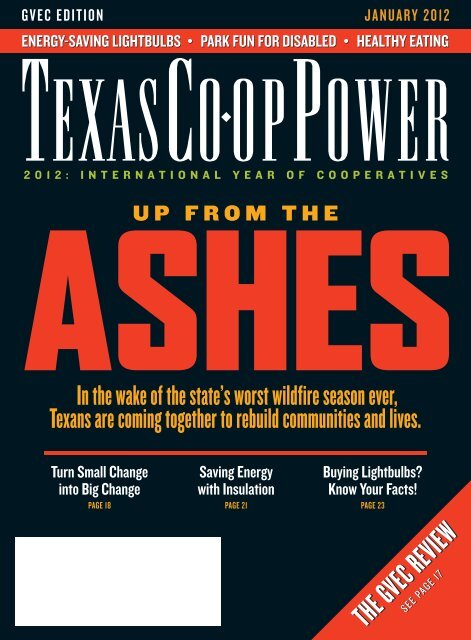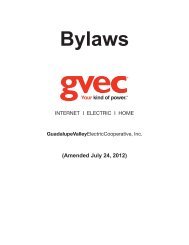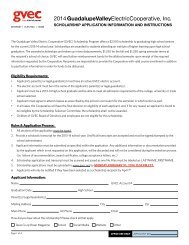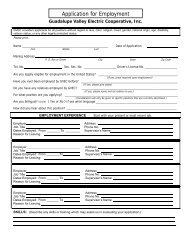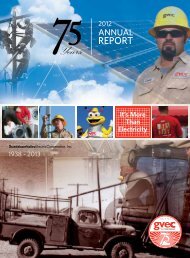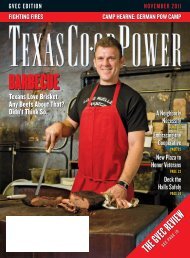THE GVEC REVIEW - Guadalupe Valley Electric Cooperative
THE GVEC REVIEW - Guadalupe Valley Electric Cooperative
THE GVEC REVIEW - Guadalupe Valley Electric Cooperative
Create successful ePaper yourself
Turn your PDF publications into a flip-book with our unique Google optimized e-Paper software.
<strong>GVEC</strong> EDITION<br />
JANUARY 2012<br />
ENERGY-SAVING LIGHTBULBS • PARK FUN FOR DISABLED • HEALTHY EATING<br />
2012: INTERNATIONAL YEAR OF COOPERATIVES<br />
UP FROM <strong>THE</strong><br />
ASHES<br />
In the wake of the state’s worst wildfire season ever,<br />
Texans are coming together to rebuild communities and lives.<br />
Turn Small Change<br />
into Big Change<br />
PAGE 18<br />
Saving Energy<br />
with Insulation<br />
PAGE 21<br />
Buying Lightbulbs?<br />
Know Your Facts!<br />
PAGE 23<br />
S E E PA PAG E 1 7<br />
<strong>THE</strong> <strong>THE</strong> <strong>GVEC</strong> <strong>GVEC</strong> <strong>REVIEW</strong> <strong>REVIEW</strong>
vol. 38, no. 1<br />
the<br />
review<br />
January 2012<br />
2012 <strong>GVEC</strong> Business Plan<br />
ith the New Year comes a fresh perspective on what lies<br />
W ahead for the <strong>Cooperative</strong>. The 2012 <strong>GVEC</strong> Business<br />
Plan, as in years past, is developed by the Board of Directors<br />
and staff to outline the strategic vision for <strong>GVEC</strong>’s services for<br />
the next five years as well as define the goals and objectives<br />
for the current operating year. A great deal of time and effort<br />
is put into the development and contents of the plan, and as<br />
such, represents our commitment to you, our members. This<br />
year’s plan takes a more comprehensive look at <strong>GVEC</strong>’s Core<br />
Services, which include Energy and Delivery, as well as the<br />
<strong>GVEC</strong> subsidiary companies: <strong>GVEC</strong>.net, <strong>GVEC</strong> Home and<br />
the <strong>Guadalupe</strong> <strong>Valley</strong> Development Corporation (GVDC). It<br />
reflects where we believe <strong>GVEC</strong> needs to be five years from<br />
now and will serve as a road map for our employees.<br />
The five-year outlook included in the 2012 Plan is especially<br />
significant since 2016 will mark the end of <strong>GVEC</strong>’s long-term<br />
wholesale power agreement with the Lower Colorado River<br />
Authority (LCRA). Energy Services will focus on meeting the<br />
current and future energy needs of the growing <strong>GVEC</strong> service<br />
territory, while managing the transitional issues associated<br />
with the termination of the LCRA contract.<br />
Since <strong>GVEC</strong>’s creation in 1938, our most basic function has<br />
been the delivery of electricity to our member-owners. Delivery<br />
Services’ focus will continue to ensure that power will be<br />
available when our members need it, each and every time.<br />
In addition to increasing system reliability through reduced<br />
outage times, we will also concentrate on increasing the overall<br />
efficiency of our electric grid, resulting in fewer line losses and<br />
greater savings for our membership.<br />
subsidiaries offer valuable services that enhance members’<br />
lives and are in line with our cooperative values and goals.<br />
The Operational Plan also includes the traditional focus<br />
areas, such as employees, enhancing our communication with<br />
members, providing customer-focused service, maintaining<br />
financial strength, and business development and planning.<br />
These areas include a number of projects which will keep us<br />
progressively moving forward and guide us in achieving goals<br />
as each project is completed in 2012.<br />
The <strong>GVEC</strong> Business Plan is not a document that is developed<br />
simply to be placed in a drawer and reviewed at the end of<br />
the year. It is a working document which the Board and staff<br />
review on a monthly and quarterly basis to ensure that we are<br />
on our way to realizing our five-year vision for all of <strong>GVEC</strong>’s<br />
services.<br />
By completing our tasks, meeting our benchmarks and<br />
maintaining strong financial positions, we will continue<br />
to provide the level of service that the <strong>GVEC</strong> membership<br />
expects of us and that we expect of ourselves.<br />
Thank you for your support and involvement in the business<br />
of <strong>GVEC</strong>. Contact me any time via phone at 800.223.4832,<br />
email at dschauer@gvec.org, or mail at P.O. Box 118,<br />
Gonzales, TX 78629.<br />
Respectfully,<br />
A significant addition to the 2012 Plan is the inclusion of a<br />
strategic vision for each of the <strong>GVEC</strong> subsidiaries. Whether<br />
it be providing high-speed wireless Internet access, installing<br />
and maintaining high efficiency heating and cooling systems,<br />
or assisting water supply corporations through GVDC, the<br />
District 1<br />
Robert J. Werner<br />
District 2<br />
Lewis Borgfeld,<br />
Board President<br />
District 3<br />
Henry “Bubba” Schmidt, Jr.<br />
District 4<br />
Shawn Martinez<br />
District 5<br />
Morris Harvey<br />
District 6<br />
Emmett Engelke<br />
District 7<br />
Melvin E. Strey,<br />
Board Vice President<br />
District 8<br />
Mark Roberts<br />
District 9<br />
Dr. Tom DeKunder<br />
District 10<br />
Don Williams,<br />
Board Secretary/Treasurer<br />
District 11<br />
David Warzecha<br />
800.223.<strong>GVEC</strong> (4832) | info@gvec.org | www.gvec.org |<br />
January 2012 TEXAS CO-OP POWER 17
&<br />
PENNIES FOR<br />
STRONGER<br />
COMMUNITIES.<br />
Q: What is the POWER UP mission?<br />
A: To accumulate funds and reinvest the<br />
money in our communities by providing<br />
funding assistance to local nonprofit groups<br />
and civic organizations for community<br />
development and improvement projects.<br />
Q: What kinds of projects/programs<br />
are eligible?<br />
A: There are six areas of focus:<br />
• Education<br />
• Youth Programs<br />
• Healthcare<br />
Q: What is ineligible for grants?<br />
A: Completed projects, debt-reduction<br />
campaigns, capital projects, religious or<br />
church-sponsored facilities limited to church<br />
membership, general operating costs, office<br />
or administrative projects and equipment,<br />
land acquisition projects, computer<br />
equipment and software are not eligible.<br />
Also, for-profit entities and individuals are<br />
not eligible to receive grants.<br />
Q: What is the application<br />
evaluation process?<br />
A: A seven-member grant committee,<br />
representing <strong>GVEC</strong>’s service areas, will<br />
evaluate and score the requests based on:<br />
Time to Turn<br />
Small Change<br />
into Big Change<br />
Applications for Community<br />
Grants Due February 15!<br />
• Community Development<br />
• Civic and Community Outreach<br />
• Public Safety/Service Organizations<br />
Q: Are there eligibility requirements?<br />
A: Yes, to be eligible:<br />
• Projects must lie within <strong>GVEC</strong>’s<br />
geographic service territory.<br />
• Projects must be completed within 12<br />
months of the grant money award date.<br />
• The property owner must be the<br />
applicant.<br />
• The organization must contribute to the<br />
community’s health or welfare.<br />
• Potential benefit to the residents of the<br />
<strong>GVEC</strong> service area.<br />
• Results that can be evaluated.<br />
• Prior history if POWER UP funds were<br />
received previously.<br />
Q: What is the application deadline?<br />
A: There will be two funding periods each year.<br />
Applications are due February 15 for grants<br />
announced in April and August 15 for grants<br />
announced in October.<br />
Applications are available at any <strong>GVEC</strong> office<br />
or at www.gvec.org. They must be received<br />
by 5 p.m. on the deadline date. (Postmark<br />
date will not be considered.) If the deadline<br />
falls on a holiday or weekend, it will be<br />
extended to the next regular business day.<br />
Thanks to the generosity of<br />
participating <strong>GVEC</strong> members<br />
donating to the POWER UP<br />
Community Fund, it’s time to put<br />
those pennies to work! Applications<br />
for grants are now being accepted from<br />
nonprofit organizations that would<br />
like funding assistance for a program<br />
or project benefiting the community.<br />
Applications must be received by<br />
5 p.m. February 15, 2012, for the first<br />
distribution taking place in April.<br />
“The POWER UP program exemplifies<br />
one of the most fundamental values of<br />
cooperatives – that of neighbor helping<br />
neighbor,” says Darren Schauer, <strong>GVEC</strong><br />
General Manager and CEO. “As our<br />
communities continue to grow and<br />
develop, it’s more important than ever<br />
that we be there for each other. Through<br />
the strength of individual pennies, <strong>GVEC</strong><br />
members are coming together to help<br />
neighbors in need and support initiatives<br />
to enhance the community as a whole.”<br />
To help make it easier to apply, we’ve<br />
put together this Q&A with more<br />
information about eligibility and the<br />
application process. Applications can<br />
be picked up at any <strong>GVEC</strong> area office<br />
or downloaded from www.gvec.org.<br />
Don’t miss the February 15, 2012,<br />
deadline!<br />
Questions?<br />
Contact <strong>GVEC</strong>’s Public Relations<br />
Manager, Barbara Kuck, at<br />
830.857.1116.<br />
• The organization’s services must be<br />
nondiscriminatory in nature.<br />
Upon the project’s completion, grant<br />
recipients must furnish a final report on the<br />
project, including receipts for materials,<br />
supplies and anything else related to the use<br />
of POWER UP grant funds.<br />
Q: What information is required on<br />
the application?<br />
A: The applicant must provide basic<br />
information, a project description, budget,<br />
an IRS tax exemption determination letter,<br />
a list of the board of directors, letters of<br />
support, and a list of matching donations<br />
and in-kind contributions with supporting<br />
documentation.<br />
18 TEXAS CO-OP POWER January 2012<br />
January 2012 TEXAS CO-OP POWER 19
A New Year’s<br />
Worth of Safety<br />
Taking steps to make your family and<br />
home safer is kind of like exercising:<br />
you know it’s good for you, but don’t<br />
always do it. But the fact is, taking<br />
time out for safety not only can help<br />
save lives, but property, too.<br />
JANUARY<br />
When was the last time you put<br />
batteries in your smoke detector/<br />
carbon monoxide alarms? Replace<br />
batteries at least once a year,<br />
preferably on a noteworthy date<br />
like January 1st or your birthday. If<br />
you don’t have any of these safety<br />
devices, now is a good time to<br />
install them. Create a fire escape<br />
plan, too, and practice it twice a<br />
year.<br />
<strong>GVEC</strong> would like to help make safety<br />
in 2012 more than just an exercise,<br />
which is why we’re giving you one tip<br />
a month to act on. For any tip you’d<br />
like to know more about, go to<br />
www.gvec.org and click on the “12 in<br />
FEBRUARY<br />
Do you have pets or small children at<br />
home? Consider replacing traditional<br />
electrical outlets with newer<br />
tamper-resistant ones for safety’s<br />
sake. Now’s the time to check your<br />
extension cords, too! They can be<br />
a fire hazard if they’re overloaded<br />
with more plugged-in items than the<br />
cords are rated for, the cords are<br />
under a rug or furniture, or the cord<br />
or plug is damaged.<br />
MARCH<br />
Kids will be kids when playing<br />
outdoors. But you can make sure<br />
they play safer by pointing out<br />
electrical dangers. Tell them not<br />
to fly kites or airborne toys around<br />
power lines. Or retrieve anything<br />
tangled in a line, climb utility poles,<br />
enter an electric substation, or play<br />
around pad-mounted transformers<br />
(big green boxes).<br />
Tips for<br />
2012<br />
2012” icon for in-depth information.<br />
We’ll also be sending safety reminders,<br />
so “Like” us on Facebook and Twitter.<br />
Have a safe and prosperous year with<br />
these 12 monthly tips for 2012!<br />
APRIL<br />
Planting a tree? Building a fence<br />
or deck? Before you begin, call<br />
800-Dig-Tess (800-344-8377) to<br />
locate underground electric lines<br />
and utilities before you dig — it<br />
could save a life and it’s the law.<br />
Ask an<br />
Energy Expert<br />
Clint Petras, Member Service Advisor<br />
SAVING ENERGY With Insulation<br />
Q: How do I know if my home has<br />
enough attic insulation? Does it<br />
really make a difference?<br />
Unless your home was specially<br />
constructed for energy efficiency, you<br />
can usually reduce your energy bills<br />
by adding more insulation. Many older<br />
homes have less insulation than homes<br />
built today, but adding insulation to<br />
a newer home may also pay for itself<br />
within a few years. With adequate attic<br />
insulation, your home’s heating/cooling<br />
system will operate more efficiently,<br />
keeping you cooler in the summer and<br />
warmer in winter.<br />
Before adding insulation, you’ll need<br />
to determine how much is already<br />
installed, its kind and thickness. You’ll<br />
also need to know the R-value of existing<br />
attic insulation, which indicates the<br />
insulation’s resistance to heat. The higher<br />
the R-value, the greater the insulating<br />
effectiveness.<br />
Next you’ll need to decide what kind of<br />
insulation to install: blown (loose-fill) or<br />
blanket (batts or rolls). Blown insulation<br />
is the most commonly used type in our<br />
area and consists of small particles of<br />
fiberglass, rockwool, cellulose, or other<br />
materials. Blanket insulation is made<br />
from mineral wool and natural fibers. In<br />
general, loose-fill insulation is usually<br />
less expensive to install because it’s less<br />
labor intensive and can provide better<br />
coverage.<br />
One more thing: make sure you<br />
take care of all other efficiency<br />
improvements in your attic first, such<br />
as sealing leaky air ducts or caulking.<br />
You don’t want to come back to<br />
make repairs that might damage the<br />
insulation job.<br />
Remember, we’re here to answer your<br />
energy efficiency questions and help<br />
advise you on how to make your home<br />
more comfortable. <strong>GVEC</strong> members<br />
have access to free services, including<br />
energy efficiency rebates, free in-home<br />
energy audits and online tools such<br />
as energy calculators and interactive<br />
demonstrations at www.gvec.org.<br />
MAY<br />
Spring is perfect for home<br />
improvement projects, but first<br />
make sure your power tools are UL<br />
rated, cords aren’t frayed, plugs<br />
aren’t broken, and extension cords<br />
used are rated for outdoor use.<br />
Using a ladder? Keep it at least two<br />
times its length away from power<br />
lines in case it falls, and when<br />
carrying or setting it up, make sure<br />
there are no electric lines overhead.<br />
JUNE<br />
When is the last time you had a<br />
family talk about summertime<br />
safety? They may know that water<br />
and electricity don’t mix — but<br />
are they really aware of the many<br />
everyday hazards like using an<br />
electric radio near a pool? Do they<br />
know the new rule of thumb for<br />
lightning safety? “When thunder<br />
roars, go indoors!”<br />
JULY<br />
Have you thought about putting<br />
together an “emergency grab ‘n’ go<br />
kit” if you need to quickly evacuate<br />
from your home? What about a<br />
home emergency kit for stormy<br />
weather? Hopefully you won’t<br />
need these kits, but you can’t go<br />
wrong by taking time to assemble<br />
them.<br />
AUGUST<br />
Remind your family to be alert<br />
to signs of potential electrical<br />
problems in your home that could<br />
lead to an electrical fire. They<br />
include breakers that trip or fuses<br />
that blow often, cords and wall<br />
plates that are hot to the touch or<br />
discolored, or crackling, sizzling<br />
or buzzing sounds heard from wall<br />
outlets.<br />
Start the New Year<br />
in Comfort!<br />
Stay warm and cozy in the winter and<br />
cool and comfy in the summer<br />
with a Comfort Check Service Plan!<br />
Fast. Affordable.<br />
Reliable. Internet.<br />
Play games, watch movies,<br />
stream music, and more —<br />
faster with <strong>GVEC</strong>.net.<br />
SEPTEMBER<br />
Would you know how to cut off<br />
electric power in your home if<br />
necessary? Be prepared for<br />
emergencies: know where your<br />
breaker box (or fuse box) is,<br />
how to cut the current and have<br />
circuits (stove, kitchen lights, etc.)<br />
labelled. Also, make sure adult<br />
family members know where the<br />
water cutoff is, too.<br />
OCTOBER<br />
Did you know homes built 20<br />
years ago may not be wired to<br />
safely handle today’s electrical<br />
load? If you have any warning<br />
signs of electrical overload, find<br />
yourself using extension cords on a<br />
regular basis, or simply never had<br />
a certified electrical professional<br />
check out your home – it may be<br />
time to do it!<br />
NOVEMBER<br />
Do you know what to do if there<br />
is a prolonged electrical outage?<br />
Review the steps to take at<br />
www.gvec.org, including putting<br />
<strong>GVEC</strong>’s phone number for reporting<br />
outages into your cell phone or<br />
phone book so it will always be<br />
handy. It’s 800.223.4832.<br />
Pick up a glow-in-the-dark magnet<br />
at any <strong>GVEC</strong> office!<br />
DECEMBER<br />
Everyone likes to save money,<br />
but when it comes to electrical<br />
decorations and devices, cheaper<br />
may not be better. Check all lights,<br />
decorations, extension cords and<br />
portable outlets (old as well as<br />
new) to make sure they are UL<br />
rated. The UL label means the<br />
items are safety certified by a<br />
recognized testing laboratory.<br />
TACLB016098E<br />
Regular service will help you:<br />
• Keep cooling & heating costs in check<br />
through more efficient operation<br />
• Detect problems early<br />
• Extend equipment life<br />
• Enjoy year-round comfort<br />
Find out how regular<br />
maintenance can save<br />
you money! Call us now!<br />
For <strong>GVEC</strong><br />
Members: Add<br />
payments to your<br />
electric bill for<br />
convenience!<br />
800.223.<strong>GVEC</strong> (4832)<br />
www.gvec.org | homeservices@gvec.org<br />
• Plans starting as low as $29.95 a month<br />
• Friendly hometown service<br />
and technical support<br />
• Email spam and virus filtering<br />
• Web hosting<br />
Call & Sign Up Today!<br />
M-F: 7:30AM - 8PM<br />
SAT: 9AM - 3PM<br />
ONLY $99<br />
INSTALL<br />
800.699.<strong>GVEC</strong> (4832)<br />
www.gvec.org<br />
Cut along the dotted line and hang these tips on your fridge or office wall!<br />
20 TEXAS CO-OP POWER January 2012<br />
<strong>GVEC</strong> Home Services, Inc. and GVEc.net are subsidiaries of<br />
January 2012 TEXAS CO-OP POWER 21
Protect Your Neighbor<br />
and Our Linemen<br />
3 Safety Tips When<br />
Using a Generator<br />
Most people don’t use their portable<br />
generators on a regular basis, so it’s easy<br />
to forget the danger they can pose. Here<br />
are three very important tips to keep you<br />
and others safe:<br />
1. AVOID BACKFEEDING. Don’t plug<br />
the generator into a wall outlet; plug<br />
appliances directly into the generator.<br />
Otherwise your portable generator will<br />
“backfeed” electricity up the line, risking<br />
the lives of your neighbors and linemen<br />
who are working to restore your power.<br />
You may, if absolutely necessary, use<br />
a heavy duty outdoor-rated extension<br />
cord that is rated (watts or amps) at<br />
least equal to or greater than the sum<br />
of the connected appliance loads. Make<br />
sure the cord doesn’t have any splits or<br />
cuts and the plug has all three prongs.<br />
2. BEWARE OF CARBON MONOXIDE<br />
POISONING. Never use a generator<br />
indoors, including homes, garages,<br />
basements, crawl spaces and other<br />
enclosed or partially enclosed<br />
areas —even with ventilation.<br />
Opening doors and windows or<br />
using fans will not prevent carbon<br />
monoxide buildup. Be sure to install<br />
a carbon monoxide alarm to monitor<br />
this invisible danger.<br />
3. PREVENT FIRES. Never store fuels<br />
for your generator in the home. If the<br />
fuel spills or the container isn’t sealed<br />
properly, invisible vapors can travel<br />
along the ground and be ignited by the<br />
appliance’s pilot light or by arcs from<br />
electric switches in the appliance.<br />
Before refueling, turn the generator off<br />
and let it cool down. Gasoline spilled on<br />
hot engine parts could ignite.<br />
New Year, New Budget? Make one that works!<br />
By Lisa Hughes-Daniel<br />
Who isn’t trying to pare down the household<br />
budget these days? There’s just one problem – it<br />
can be tough to turn good intentions into dollars<br />
saved. If you’re like most people, you’ve created<br />
many well-meaning spending plans that fall flat<br />
after a few months. But don’t be discouraged;<br />
it can be done. Here are a few steps to help<br />
overcome obstacles so you can turn your<br />
balance sheet around:<br />
1. SET GOALS — the more concrete they are,<br />
the greater your chance of success. Decide<br />
what you want to accomplish and the steps<br />
you need to take. Think short- and longterm.<br />
Then write down specific goals, such<br />
as “put $300 a month into an emergency<br />
fund” or “pay an additional $200 a month<br />
on my credit card balance.”<br />
2. FIND OUT WHERE YOUR MONEY’S<br />
GOING – before any plan will work,<br />
you need a clear picture of current<br />
expenditures. Collect this past year’s<br />
bank and credit card statements. Group<br />
expenses into categories and list every<br />
expenditure. Divide the total by 12 to get<br />
your average monthly outflow of dollars.<br />
Then divide the category totals by 12 to<br />
see how costs break down each month.<br />
This small investment of time can provide<br />
invaluable insights into spending patterns.<br />
3. CARVE OUT DOLLARS – make choices<br />
you can live with that will move you in the<br />
right financial direction. Decide which<br />
habits need to be changed to meet your<br />
goals and quantify them. For example,<br />
if you cut out two restaurant visits a<br />
month, how much extra could go into your<br />
emergency fund?<br />
4. CREATE ACCOUNTABILITY – use a<br />
system that discourages “cheating.” You<br />
might use a debit card or cash rather<br />
than a credit card, for example, so money<br />
comes directly from your checking<br />
account and has finite limits. Or, set up<br />
automatic payments to a savings account<br />
or credit card account to meet your goal.<br />
Every quarter, tally your average expenditures.<br />
Pat yourself on the back if you’re moving<br />
in the right direction. Or, make additional<br />
adjustments, if needed, and keep working<br />
towards your goal.<br />
Encourage your high school student<br />
to apply! Deadline is Feb. 1, 2012!<br />
Win a Trip to<br />
earn $2,500 cash<br />
for college<br />
youthtour@gvec.org<br />
Get details and deadlines at www.gvec.org!<br />
800.223.<strong>GVEC</strong> (4832)<br />
www.gvec.org<br />
Shopping for lightbulbs? Look for lumens, not watts!<br />
Lighting Facts<br />
Per Bulb<br />
Brightness XXX lumens<br />
Estimated Yearly $X.XX<br />
Energy Cost<br />
Based on 3 hrs/day,<br />
11¢/kWh. Cost<br />
depends on rates and use.<br />
Life<br />
X.X years<br />
Based on 3 hrs/day<br />
Light Appearance<br />
Warm<br />
Cool<br />
XXXX K<br />
Brightness<br />
XXX<br />
lumens<br />
Estimated<br />
Energy Cost<br />
$X.XX<br />
per year<br />
XX watts<br />
Energy Used<br />
Contains Mercury<br />
For more on clean up<br />
and safe disposal,<br />
visit epa.gov/cfl.<br />
Do you read product labels? You may have<br />
noticed there’s a new label in town — on<br />
lightbulb packages. With the arrival of more<br />
efficient lightbulbs, this new Light Facts Label is<br />
designed to help consumers buy bulbs that are<br />
right for them by comparing bulb brightness,<br />
color, lifespan, and the yearly estimated<br />
operating cost.<br />
The biggest change is how we buy lightbulbs.<br />
For decades we’ve bought them based on<br />
“watts,” which measured how much energy they<br />
consume. But now, with the variety of energy<br />
efficient bulbs available, you’ll buy them based<br />
on “lumens,” which tells you how much light<br />
they give — the amount or level of brightness.<br />
More lumens mean brighter light; fewer lumens<br />
mean a dimmer light. So the next time you<br />
shop, think lumens, not watts.<br />
For example, to replace a 100-W traditional<br />
incandescent bulb, look for one that gives you<br />
about 1600 lumens.<br />
• Replace a 75-W bulb with an energy-saving bulb that gives you about<br />
1100 lumens.<br />
• Replace a 60-W bulb with an energy-saving bulb that gives you about<br />
800 lumens.<br />
• Replace a 40-W bulb with an energy-saving bulb that gives you about<br />
450 lumens.<br />
To learn more about lighting options and other ways to save<br />
energy at home, visit www.energysavers.gov.<br />
Source: Energy Savers, U.S. Department of Energy<br />
Did you know that up to 12 percent of a typical monthly electric bill is for lighting?<br />
You can reduce the amount of energy used by turning off lights when leaving a room and<br />
by replacing bulbs with energy efficient ones. As part of new energy efficiency standards<br />
set by Congress, a new generation of incandescent lightbulbs will be sharing the shelf<br />
with other energy efficient options such as CFLs and LEDs. The new, more efficient<br />
incandescent bulbs may cost a little more, but they should use less energy and last<br />
longer. The new lightbulb efficiency standards begin this year and by 2020, light bulbs<br />
must be 70 percent more efficient than traditional incandescents.<br />
?<br />
What Are<br />
My Lighting<br />
Options?<br />
Starting in 2012,<br />
lightbulbs must be<br />
more energy efficient.<br />
The three most<br />
common bulb options<br />
consumers will find on<br />
store shelves are:<br />
Halogen incandescents<br />
Energy Savings:* 25 percent<br />
Lifespan:* Three times longer<br />
Annual Energy Cost: $3.50<br />
Compact Fluorescent<br />
Lamps (CFLs)<br />
Energy Savings:* 75 percent<br />
Lifespan:* 10 times longer<br />
Annual Energy Cost: $1.20<br />
Light-emitting diodes (LEDs)<br />
Energy Savings:* 75-80 percent<br />
Lifespan:* 25 times longer<br />
Annual Energy Cost: $1<br />
* As compared to traditional incandescent bulbs<br />
Learn more at<br />
energysavers.gov/lighting<br />
22 TEXAS CO-OP POWER January 2012<br />
January 2012 TEXAS CO-OP POWER 23
NOW WE’RE COOKING!<br />
email them to info@gvec.org<br />
Member Recipes<br />
Linda Dornburg, Goliad<br />
Baked Corn Dip<br />
1 can (15 oz.) corn, drained<br />
1 package (8 oz.) cream cheese<br />
1 can (4 oz.) green chilies, chopped<br />
1 can (4 oz.) pickled jalapenos,<br />
chopped<br />
1 cup cheddar cheese, grated<br />
(divided use)<br />
Preheat oven to 350 degrees.<br />
In a large bowl, combine all<br />
ingredients except for ½ cup grated<br />
cheddar cheese. Coat baking dish<br />
with nonstick cooking spray, then<br />
pour dip into the baking dish. Top<br />
with the remaining cheese. Bake<br />
20 to 25 minutes or until bubbly.<br />
Serve with corn chip “scoops” or<br />
other chips.<br />
Lillie Jemelka, Yoakum<br />
Shirley’s Cheese-Sausage<br />
Dip<br />
1 pound hamburger meat<br />
1 pound breakfast sausage<br />
1 onion, minced<br />
1 teaspoon garlic powder<br />
2 pounds Velveeta cheese, cubed<br />
1 can Rotel tomatoes and chilies<br />
1 can cream of mushroom soup<br />
Brown meats and sauté onion<br />
with it. Drain. Add other<br />
ingredients and mix until smooth.<br />
Serve with chips.<br />
Vernelle Jones, Kingsbury<br />
Koch Kase<br />
1 teaspoon baking soda<br />
12 oz. small curd cottage cheese<br />
¾ stick butter<br />
3 tablespoons flour<br />
½ teaspoon caraway seeds<br />
(optional)<br />
Mix baking soda with cottage<br />
cheese. Let set until foamy, about<br />
1 1 ⁄2 hours. Then melt butter; add<br />
flour, then add cheese mixture<br />
and heat to blend, but do not let<br />
mixture boil. If you choose to use<br />
caraway seeds, fold them into the<br />
mixture now. Put mixture into a<br />
glass container or a pint jar with<br />
a lid. Cool, then cover Koch Kase<br />
and refrigerate. Serve on saltine<br />
crackers with hard sausage.<br />
Community Calendar<br />
Seguin<br />
Martin Luther King, Jr. Walk<br />
January 16, 2012<br />
Join the community in a walk in memory<br />
of Dr. Martin Luther King, Jr. The event<br />
will include guest speakers. Walk begins at<br />
11:45 a.m. from Central Park in downtown<br />
Seguin to Texas Lutheran University. For<br />
info, see www.visitseguin.com.<br />
Cuero<br />
102nd Annual Membership Social &<br />
Awards Ceremony<br />
January 24, 2012<br />
Who will win the Community Service of<br />
the Year Award? Find out at the 102nd<br />
Annual Membership Social & Awards<br />
Ceremony sponsored by the Cuero Chamber<br />
of Commerce Agriculture & Visitor’s Center.<br />
The presentation is from 6-8 p.m. at Venue<br />
on Church Street, 125 E. Church St. Tickets,<br />
including dinner, are $15. For details, call<br />
361-275-2112 or visit www.cuero.org.<br />
Area Youth Livestock Shows<br />
Yoakum Project Show<br />
January 13-14, 2012<br />
Moulton Junior Livestock Show<br />
January 15-16, 2012<br />
<strong>Guadalupe</strong> County Youth Livestock and<br />
Homemakers Show<br />
January 18-21, 2012<br />
Hallettsville Junior Livestock Show<br />
January 21-23, 2012<br />
Wilson County Junior Livestock Show<br />
January 24-28, 2012<br />
Nordheim FFA Stock Show/Foods and<br />
Crafts Show<br />
January 28, 2012<br />
All dates are subject to change without<br />
notice. Please check with your local school,<br />
agricultural department, extension office or<br />
4-H leader to confirm the livestock show date<br />
in your area.<br />
We welcome your input and questions!<br />
Recipes, photos, stories about you, your family, and communities! Always<br />
feel free to contact us with information for the <strong>GVEC</strong> Review or any<br />
questions you may have for us. Email info@gvec.org, write to us at P.O.<br />
Box 118, Gonzales, TX 78629, or phone us at 800.223.4832.<br />
24 TEXAS CO-OP POWER January 2012<br />
1.800.223.<strong>GVEC</strong> (4832)<br />
info@gvec.org<br />
www.gvec.org


